Browse Exhibits (18 total)
IU Institute for Advanced Study: Repository Research Fellowship Project

Repository Research Fellow and New Orleans-based artist, Natan Diacon-Furtado used Wylie House Museum and IU Archives collections to inform his projected light patterns in the museum. His pieces are representative of the lives of three lesser-known individuals who called Wylie House home for varying periods of time. Exhibit opening: September 17, 2021.
Andrew and Theophilus Wylie: Leadership at Indiana University, 1820-1890
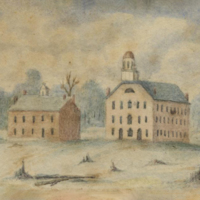
This exhibit highlights the leadership of Andrew Wylie, Theophilus A. Wylie, and, by extension, Indiana University Bloomington between 1829 (Andrew Wylie’s first year as president of Indiana University) and 1895 (Theophilus Wylie’s death). It explores primary materials related to nineteenth-century publication, education, presidential addresses, public science, scholarly libraries, science and religion, student experiences, and the Civil War.
Call and Response: Creative Interpretations of the Wylie House

The Call and Response: Creative Interpretations of the Wylie House exhibition is an artistic extension of the Wylie House Museum’s commitment to share the lesser-known histories of people associated with the 1835 Indiana home. Initially a phsyical exhibition in early 2020, this digital component features the individual artists and links to a virtual tour of the original exhibition in the historic home.
Early Photography and Portraiture at Wylie House

Capturing the likeness of yourself or your loved one was not always as simple as pressing a button. The Indiana frontier had few professional artists, and faithful oil portraits were expensive and hard to come by. Itinerant silhouette cutters filled the gap, and later, daguerreotypes and other forms of early photography brought lifelike portraiture to Indiana. Theophilus Wylie was a pioneer of photography in the state, and soon other photographers followed in his footsteps.
Elizabeth Bishop Letters, 1924-1950

One of the Wylie House’s more notable and surprising archival collections consists of letters to Louise Bradley, great-granddaughter of Theophilus A. Wylie, from Elizabeth Bishop, Pulitzer Prize winner and one-time Poet Laureate. These letters, which span 25 years, paint a unique picture of Bishop’s development from precocious adolescent to accomplished writer and preserve a friendship that played an important role in both women’s lives.
Elizabeth Breckenridge, 1843-1910

What was life like for Elizabeth “Lizzie” Breckenridge (1843-1910), an African-American woman who spent most of her life living with and working as a domestic servant for the Theophilus Wylie family? Pulling from a variety of primary sources, this exhibit pieces together her life experience in the second half of the 19th century in Bloomington, Indiana.
Greek Letter Societies
Phi Beta Kappa, the first Greek letter society in the United States, was established at the College of William and Mary in 1776. Over the next century, fraternal organizations gained national prominence and soon became a collegiate tradition. Several chapters of both men’s and women’s Greek letter societies originated at Indiana University, and many members of the Wylie family played a significant role in their creation and perpetuation.
Heritage Archaeology: Agriculture to Floriculture
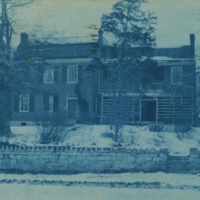
Theophilus and Rebecca Wylie moved into the Wylie House in the mid-nineteenth century, when households were transitioning from large-scale agriculture to small-scale leisure gardening, or floriculture. This exhibit showcases the June 2018 field school run by a team of Indiana University students and Glenn A. Black Laboratory of Archaeology staff to learn more about the Wylies’ garden “pits,” subterranean cold-frame greenhouses that insulated their flowers from harsh weather.
Horticulture Hysteria: The Wylie Family's participation in the 19th Century Gardening Craze
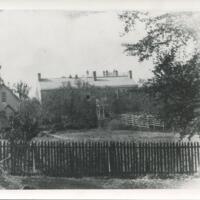
As Theophilus and Rebecca Wylie moved their family into Wylie House in 1859, a movement wasovertaking American society. An interest in horticulture, or appreciating plants apart from theirnutritional value, was no longer only for the elite, but became popular throughout all levels and locations of American society. Americans of the Victorian era believed that getting back to nature was the cure for industrialization and the ills of modernization.
Louise Bradley, 1908-1979

If anyone recognizes Louise Bradley’s name today, it is probably due not to her own talent as a writer, but to her connection with Pulitzer Prize-winning poet Elizabeth Bishop. This great-granddaughter of Theophilus and Rebecca Wylie had a creative life of her own, however, and the diary she kept in the early 1930s sheds light on her writing, her time in college and after graduation, and her career as a research worker during the Great Depression and World War II.
Maggie Wylie Martin in the Middle Kingdom, 1850-1858
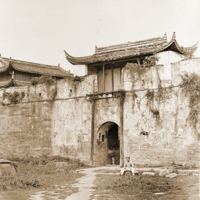
Andrew Wylie’s daughter Maggie married Samuel Martin on May 17, 1849. Six months later, on November 22, the Martins boarded a ship to China in answer to the Presbyterian Mission Board’s call for missionaries in the city of Ningpo. The couple were surprised by the premature birth of their first son, William Boone Martin, on a steamer north of Hong Kong on April 29, but they arrived safe and healthy in Ningpo one month later. Although the Martins had to leave China in 1858, their eight years in Ningpo deeply impacted the rest of their lives.
Morton C. Bradley, Jr. Education Center
The Morton C. Bradley, Jr. Education Center provides meeting, exhibit, and research space for Indiana University’s historic Wylie House Museum, which was home to four generations of Wylie family members after it was built by IU’s first president, Andrew Wylie, in 1835. The Education Center bears the name of Wylie descendent Morton C. Bradley, Jr., who bequeathed several original sculptures, a museum support fund, and a trove of family documents and heirlooms to the museum in 2004.
Naturally Beautiful at Wylie House
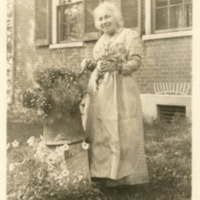
Inspired by "Naturally Beautiful," an exhibit at the Homewood Museum at John Hopkins University, "Naturally Beautiful at Wylie House" is about embracing the beauty of objects in the Wylie House while acknowledging the changes both in the climate and people's lives in Indiana over the last 200 years.
Stargazing: Re/Imagining the Life of Elizabeth “Lizzie” Breckenridge
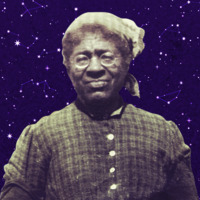
Stargazing is a multidisciplinary arts and humanities project that brought together Indiana University faculty - a poet, a choral director, and a museum archivist - to create new ways to make visible the life of Elizabeth "Lizzie" Breckenridge (1843-1910), a free woman and the domestic employee of Professor Theophilus WYlie, cousin of Andrew Wylie, the first president of IU.
Three Wylie Women: A Generation of Late Nineteenth-Century Mothers

The Wylie Women reflect contradictions between the maternal ideal, represented in women’s advice literature, and the complex realities of Midwestern, middle-class childrearing in the late nineteenth-century. This generational study of Elizabeth Louisa Wylie Boisen, Margaret Wylie Mellette, and Sarah Seabrook Mitchell Wylie examines the effect of social and economic factors on mothering experiences, revealing a shared struggle to uphold the expectations of nineteenth-century women.
Wishing Tree Project
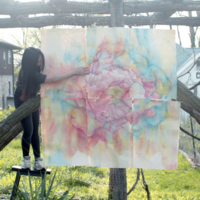
In the spring of 2020, Indiana University MFA student Christine Wang recieved an IU-Bloomington Public Arts Grant funded by the office of the Vice Provost of Research and the Arts and Humanities Council and planned to conduct several paper-making workshops and install artwork at the Wylie House Museum. Unfortunately, her work was cut short due to COVID-19. This exhibit displays the artwork she installed in the Wylie gardens and explains her message of environmental consiousness and the connection between art and the earth.
Wylie Family Tree
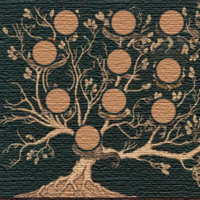
The Andrew Wylie and Theophilus Wylie families occupied the Wylie House for nearly eight decades, from 1835 until 1913. In 1912, the family gathered at the Wylie House for one final visit to celebrate the 100th birthday of Theophilus Wylie’s wife, Rebecca. Click on the photographs in this exhibit to learn more about these several generations of Wylie family members and their connections to the Wylie House.
Wylie House Quilt Collection
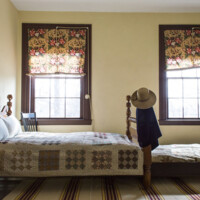
Quilts are valuable examples of practical folk art. The Wylie House quilt collection contains examples of 19th and 20th century quilts, as well as a robust collection of modern reproductions of period quilts by a volunteer group of quilters. Explore our collection and learn more about the role that they played in the lives of the Wylie family and others throughout history.
